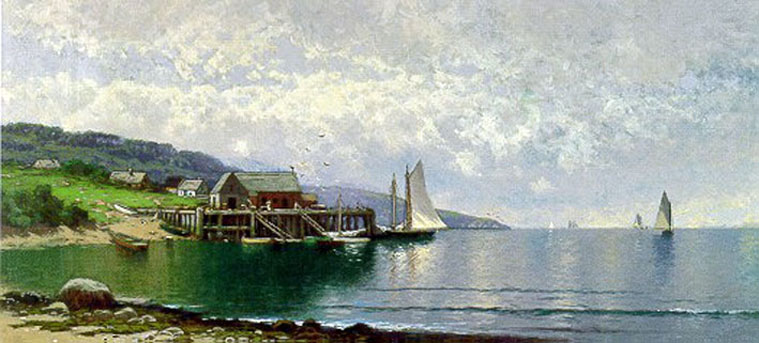

The Landing at Bailey Island, Maine: ca 1907
For over forty years Alfred Bricher sketched and painted scenes along the East Coast from New Jersey to easternmost Maine. He painted his first shore subject in 1864, when close observations of nature, both in details and in larger effects, were highly valued. He created compositions in which a strong horizon line, often no more than one-third of the way up the picture surface, and an uncommonly wide canvas, created a panoramic effect. In the foreground there is usually a thin wedge-shaped expanse of beach, then two or three slightly diagonal ranks of breaking waves. The waves and water are often within a cove created by the shore sweeping around in a tight curve, the apex of which is cut off by the picture's border. The shore then reappears to form a prominent headland in the middle distance, sloping gently or dropping steeply to a horizon punctuated only by the tiny white triangles of sails. Filling well over half the picture surface is a sky animated by a remarkably convincing combination of white and gray-edged clouds interspersed with patches of blue. Bricher was also a master of the breaking wave, able to catch the translucency at its crest, the heaving fluidity of the body and the rush of foam down its forward slope.
Bricher painted the islands of Maine in storm and lifting mist as well as sunny calm. During the last few years of his life he concentrated his sketching on the northern islands in Casco Bay including Bailey Island, northeast of Portland, one of the larger of the over two hundred islands which dot these waters. From 1905 to 1908, Bricher exhibited no less than twelve watercolors and oils of Bailey Island subjects. In 1908, Gill's Art Gallery in Springfield, Massachusetts exhibited the Butler Institutes picture. At the Bricher estate sale of 1909, there were ten additional watercolors of Bailey Island subjects.'
The Landing at Bailey Island, Maine is a calm distillation of Bricher's accomplishments. Every detail is deftly drawn, from the foreground rocks to the landing and its buildings in the middle distance, to the distant sailboats, but not so meticulously as to make the picture the sum of many parts. On the left are active colors in the seaweed and a greenish tint to the water as it becomes shallow. The sea approaches the beach in three wavelets which lap lazily against the stones. With a light impasto of lively roiling brushstrokes a placid sea mirrors the sky above. One characteristic which distinguishes Bricher's work from that of many of his contemporaries is the darkness of his shadows. Even on a sunny day his quite dark shadows create a somewhat somber effect. The structure of the landing is in shadow; but a shadow that is transparent with details of buildings and pilings readily visible.
Characteristic also is the calculation with which Bricher has composed his picture. The horizon divides it into thirds and the end of the landing pier reaches exactly the picture's midpoint. In sketches that the artist made from several different vantage points, the buildings on the pilings are in other positions and the distant shore has very different profiles. The pier itself looks just the same today, but it is in a cove which Bricher has substantially eliminated. The sailboat off the end of the pier appears in only one sketch, but in a very different relation to the distant shore beyond. Bricher has exercised substantial license in shaping and repositioning elements, creating balance and harmony for a picture of singular tranquility.
WILLIAM S. TALBOT
Quoted From: Alfred Thompson Bricher - 1837
Alfred Thompson Bricher
Alfred Thompson Bricher (born in Portsmouth, New Hampshire and died in Staten Island, New York) was a painter associated with White Mountain Art and the Hudson River School.
He began as a businessman in Boston, Massachusetts before becoming a professional painter. He studied at the Lowell Institute when not working. He also studied with Albert Bierstadt, William Morris Hunt, and others In 1868 he moved to New York City and in the 1870s primarily did maritime themed paintings.
Bircher was one of the last painters of the famed Hudson River School. By the end of his life, his style of painting that included landscapes and luminism fell out of style, with Modern Art becoming the premier artistic movement. As his style of art faded, so did his fame.
Over time Bircher's artwork garnered more attention and by the 1880's he began to be credited as one of the nineteenth century's greatest maritime painters. A self taught luminist, he explored the effects of light and how it reflected, refracted, and absorbed on landscapes and seascapes.
As a lover of maritime life and the sea he purchased a home in the 1890's close to the sea in the New Dorp section of Staten Island where he had views of the Atlantic Ocean and Raritan Bay. He lived and painted at the shore in New Dorp until his death in 1908
Sources:
Alfred Thompson Bricher - Wikipedia
Alfred Thompson Bricher Biography
Alfred Thompson Bricher Online
The Athenaeum - Displaying artworks for Alfred Thompson Bricher
Selected Works of Alfred Thompson Bricher
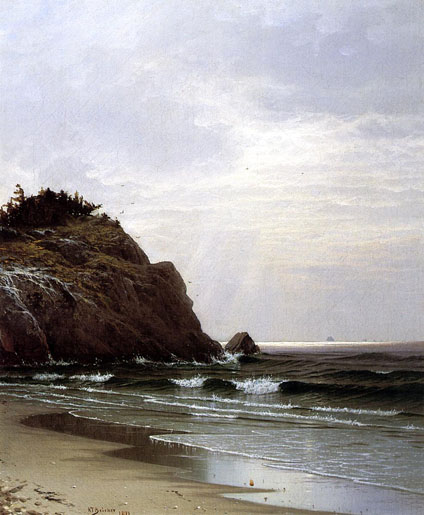
A Cloudy Day: 1871
The vertical format of Cloudy Day is unusual and only seven variations of the composition are known. The painting, Jeffrey R. Brown has written, "radiates pure naturalism", while John Wilmerding has felt that "this work was seldom surpassed in his career." A haunting tranquility permeates Bricher's canvas. Rays of light break through an overcast sky and illuminate the resplendent horizon, while breaking waves upon the beach form pristine patterns as the water slowly retreats to the sea.
The emptiness and stillness shown in Cloudy Day contrasts with Bricher's sketches made during the summer of the same year. Bricher often portrayed the human figure in his drawings which depict women shading themselves under parasols or children playing along the shore. Although the bathers are anonymously portrayed, Bricher's rapport with their activity is self-evident. Yet, in his paintings he often distills the warmth of human diversions found in his sketches and concentrates on the more formal arrangement of land and sea in depicting the coastal landscape. As Brown has observed, in Bricher's work, "one senses his isolation. Ruler-straight horizons etch the boundary of these daily experiences while the rigidity of his underlying geometric structure accentuates the clarity of his vision."
Although it has been suggested that Bricher's painting portrays Great Head, Mount Desert, Maine, there is reason to question this identification. The painting does not closely resemble Bricher's Great Head, Mt. Desert, n. d., private collection, which is titled in pencil on the stretcher; nor does it relate to a contemporary photograph of the landmark which shows a rocky promontory barren of trees. It is likely the painting portrays either the Maine coast of the north shore of Boston.
Kenneth W. Maddox
Quoted From: El Museo de arte Thyssen-Bornemisza
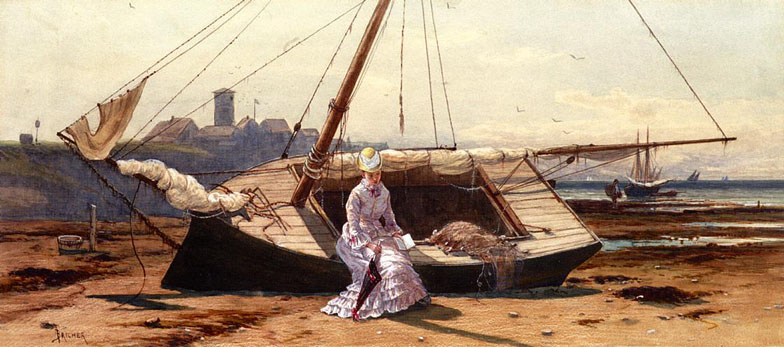
A Pensive Moment: ca 1871-75
A masterwork of American watercolor painting, Alfred Thompson Bricher's A Pensive Moment was painted around 1875-1880, at a time in the artist's career when he created some of his finest works in the medium. With virtuoso technique, Bricher incorporates a single figure into a classic seaside composition for which he is so celebrated. The artist fills the open sky with a brilliant sense of light, an artistic device recalling the luminist paintings that Bricher painted so effectively throughout his lifetime.
In his authoritative volume on the history of American drawings and watercolors, Theodore E. Stebbins, Jr. has written, "Bricher was a journeyman landscape and marine painter, yet also an active member of the Water Color Society who could rise to real heights in this medium. A Pensive Moment is worthy of Winslow Homer: drawn well, executed largely in wet washes with considerable use of pink and white body color (or gouache') in the woman's dress, it echoes the internal loneliness of the era." (American Master Drawings and Watercolors: A History of Works on Paper from Colonial Times to the Present, New York, 1976, p. 167)
Jeffrey Brown has written, "The watercolor A Pensive Moment is perhaps the most successful of these paintings of women in nature. Organized by the controlling eye of the painter, the subject is more than a nostalgic tonal photograph. It becomes instead a general statement synthesizing the sentimental attitude of the time. The boat and rigging are bound into position with the shadows and seaweed by a subtle arrangement of interlocking triangles and right angles. For A T. Bricher, carefully constructed composition is always an underlying, and sometimes too obvious strength. . . But in a painting such as A Pensive Moment, the compositional force lends a musical relation to the forms which exhale the odor of the salt sea air and recall some characteristic features, forms and attitudes at summer watering places.'" (Alfred Thomson Bricher, Indianapolis, Indiana, 1973, pp 25-26.)
Quoted From: Alfred Thompson Bricher (1837-1908) | A Pensive Moment | Christie's
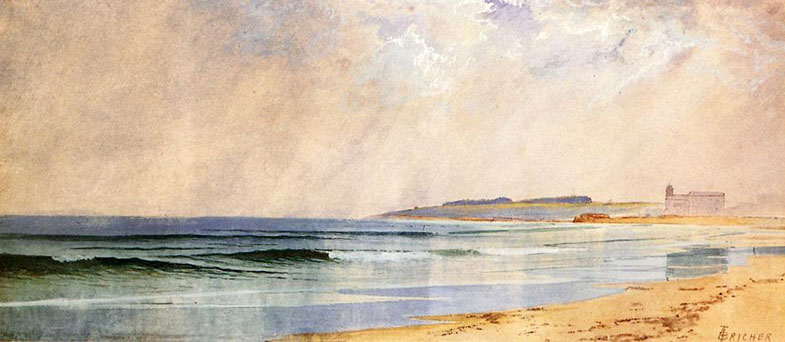
A Showery Cay - Naragansett Pier: 1871

A Walk by the Lake: 1866

Afternoon at the Shore: Date Unknown

Afternoon by the Shore: 1880
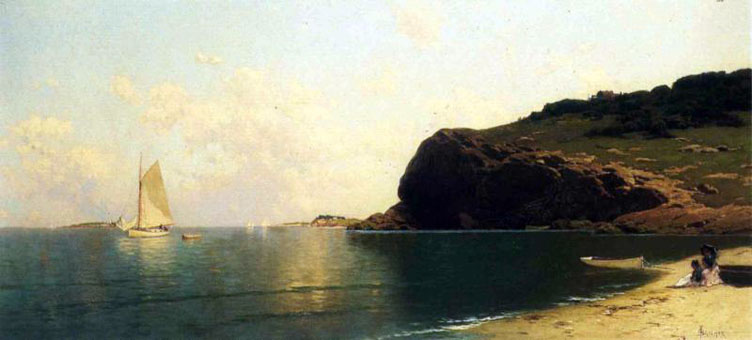
Afternoon Calm: Date Unknown
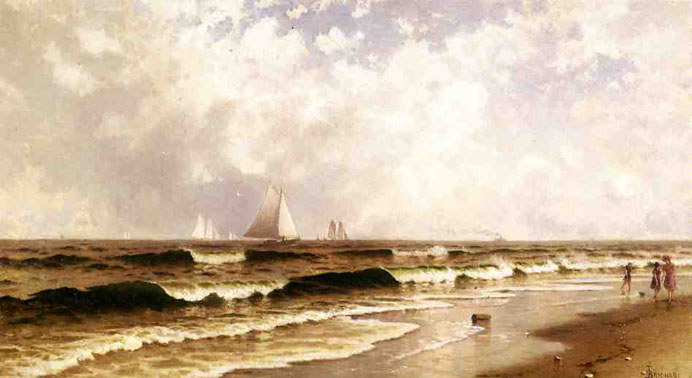
Afternoon, Southampton Beach: Date Unknown
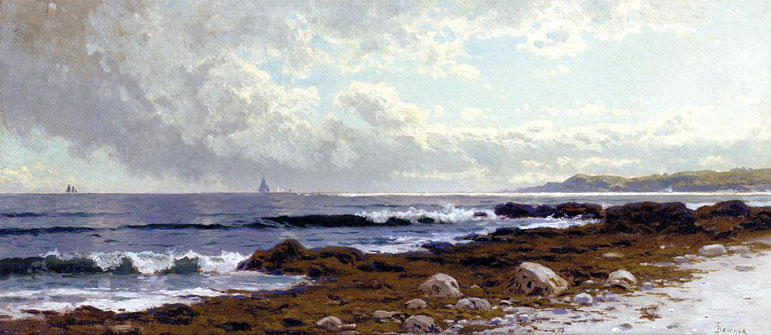
Along the Coast: Date Unknown
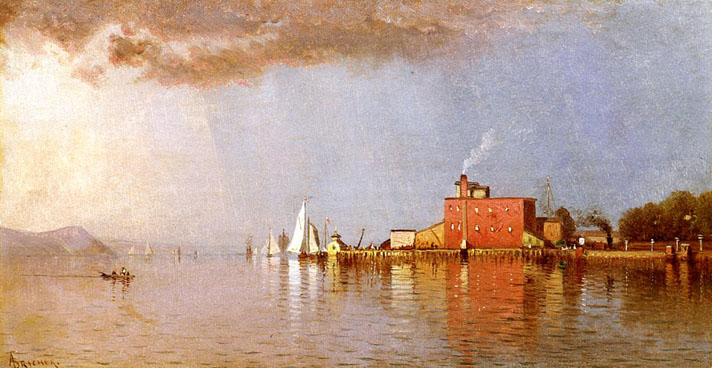
Along the Hudson: Date Unknown

Along the Shore: Date Unknown
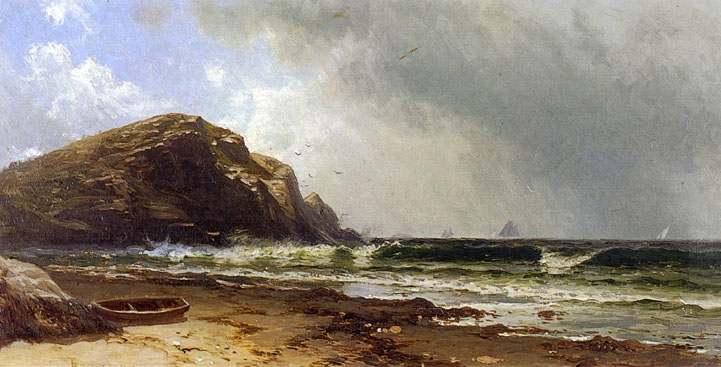
Approaching Storm: 1878
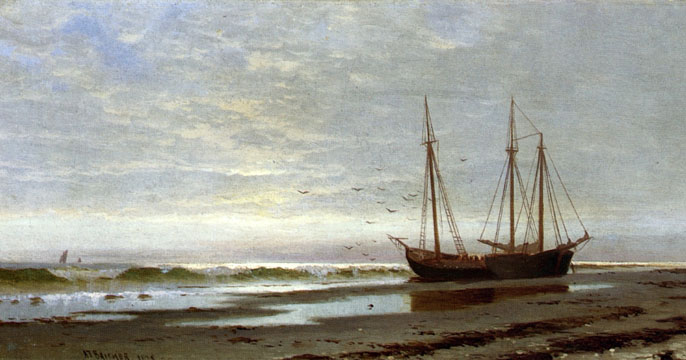
Ashore at Scituate: 1878
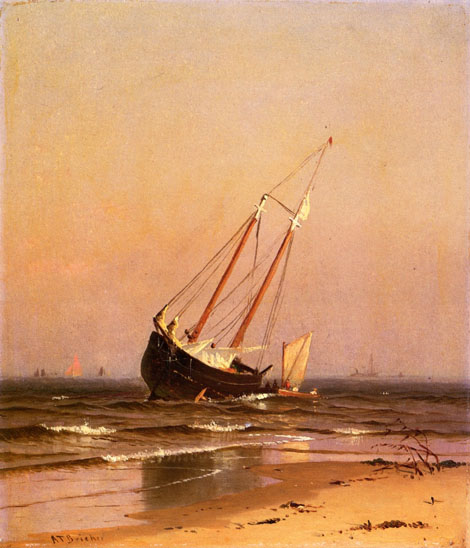
Ashore on Salisbury Beach: 1872

At the Shore: 1871
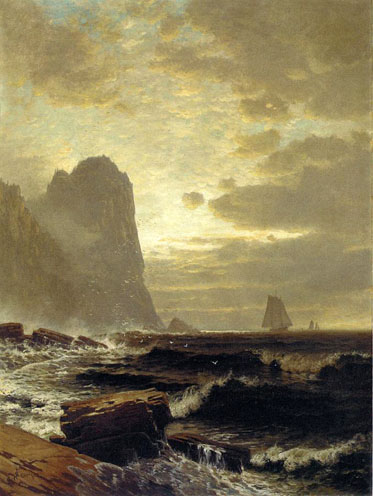
At the South Head, Grand Manan: Date Unknown
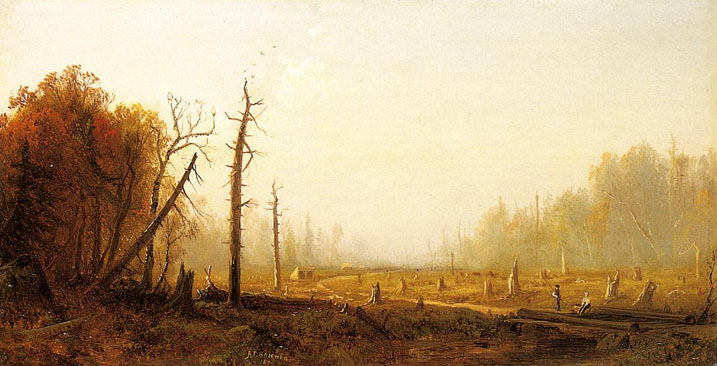
Autumn Landscape: 1870
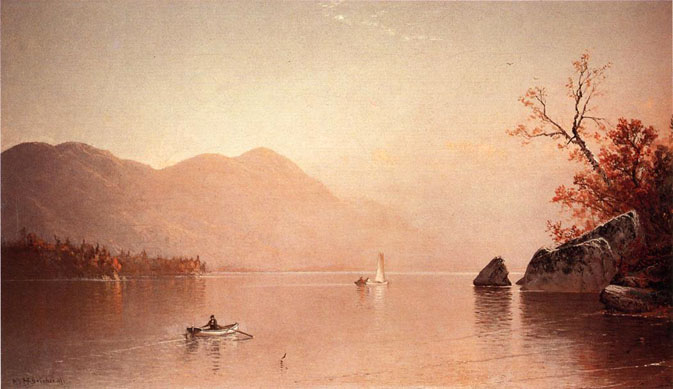
Autumn Mist, Lake George, New York: 1871
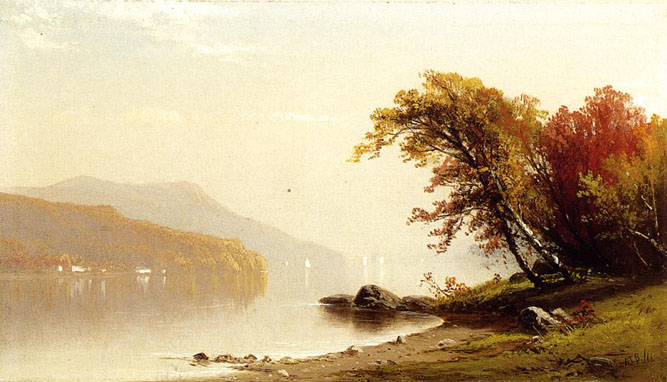
Autumn on the Lake: 1866
Another Biography of
Alfred Thompson Bricher (1937-1908)
Alfred Thompson Bricher was one of America's best-known landscape and marine painters of the nineteenth century. Unlike the artists of the two generations preceding his, who sought untamed wilderness views in the Catskill Mountains, the White Mountains, and the Adirondacks, Bricher specialized in landscapes featuring placid inland bodies of water and picturesque scenes of the New England seaboard. Today Bricher is widely appreciated by art historians for his mastery of Luminist realism alongside the slightly older generation of Hudson River School painters Fitz Hugh Lane, Sanford R. Gifford, Martin Johnson Heade, and John F. Kensett.
Bricher was born in the seafaring town of Portsmouth, New Hampshire, on April 10, 1837, and spent most of his childhood along the Atlantic seaboard at Newburyport, Massachusetts. In 1851 he began working at a Boston dry goods store-not an inauspicious start for a budding painter in an age when artistic success itself could depend in no small part upon one's mercantilist talents. It is thought that Bricher studied art concurrently at Boston's Lowell Institute, and he later maintained that painters William Stanley Haseltine (1835-1900) and Charles Temple Dix (1838-1873), whom he met on a summer sketching trip to Mount Desert, Maine, in 1858, greatly influenced his developing talent. By the mid-1860s Bricher had established himself as an artist in Boston, where he had set up a studio in the same building as Martin Johnson Heade. Not unlike Heade and other American landscapists of the day, Bricher made frequent trips inland and along the coast in order to sketch-usually in pen-and-ink or watercolor-various motifs from nature for later translation into oil paintings, which he would subsequently work up in the studio. As an example of how diligently he studied nature, certain Bricher sketches include notations specifying the exact atmospheric effects of a passing moment. Such field research had an especially profitable outcome when, in 1866, Bricher arranged to have his oil paintings translated into color lithographs by the Boston firm of L. Prang & Company, with whom he maintained a lucrative relationship for the rest of his life. Bricher became known early on for his autumnal landscapes, a uniquely American subject-as Thomas Cole, Jasper Cropsey and other painters had discovered. Bricher found the settings for his displays of warm fall colors among the bays, creeks, and meadows of Newburyport. Mill Stream at Newburyport, Massachusetts, exhibited at the National Academy of Design, New York, in 1869, is one such example, in which a quiet pond framed by overarching trees forms a placid setting for three women in a boat, which Bricher placed smartly in the left background as though to satisfy a growing popular demand at this time for paintings of figures in landscape.
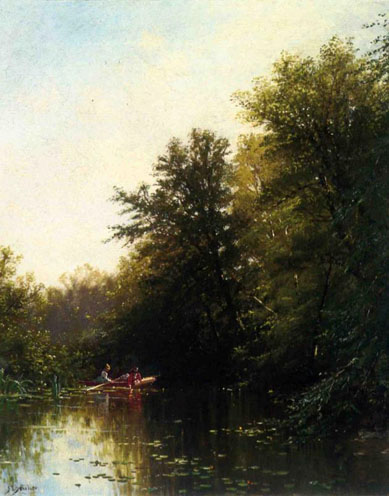
Mill Stream at Newburyport, Massachusetts
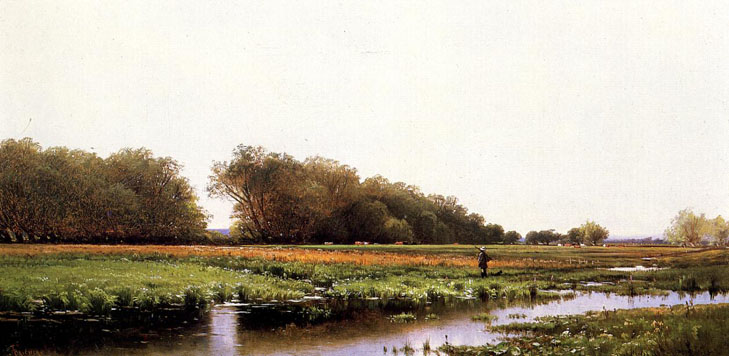
Mill Stream at Newburyport, Massachusetts
After marrying and establishing himself professionally in New York City in 1868, Bricher increasingly devoted his time to marine painting. From that time forward his palette was dominated by cool greens and blues. In the 1870's he summered at Grand Manan Island, New Brunswick. In the early 1880s he was visiting fashionable summer watering spots and including in his paintings the graceful young women of the upper classes who frequented them. He was at New Rochelle, New York, the summer of 1880, and in 1881 he found himself at Larchmont, New York, as well as at points in New Jersey, such as Montclair, Asbury Park, and Atlantic City.

Brundith Head, Grand Manan: 1899
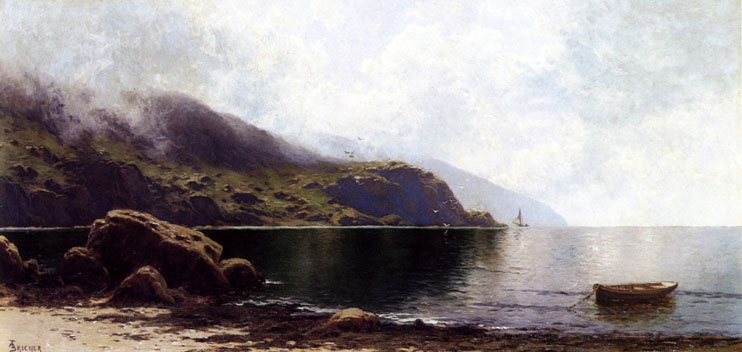
Grand Manan: Date Unknown
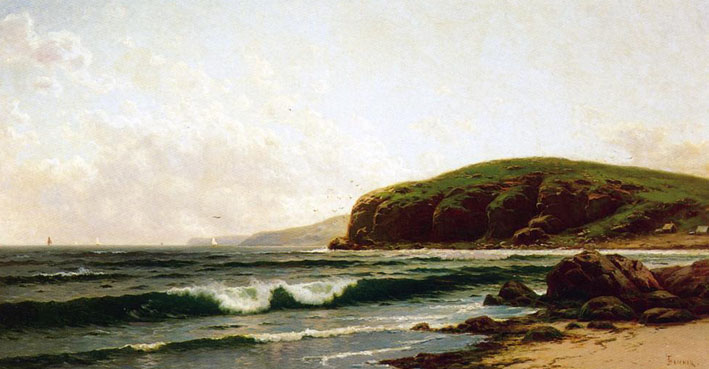
Headlands and Breakers, Grand Manan, Maine: Date Unknown
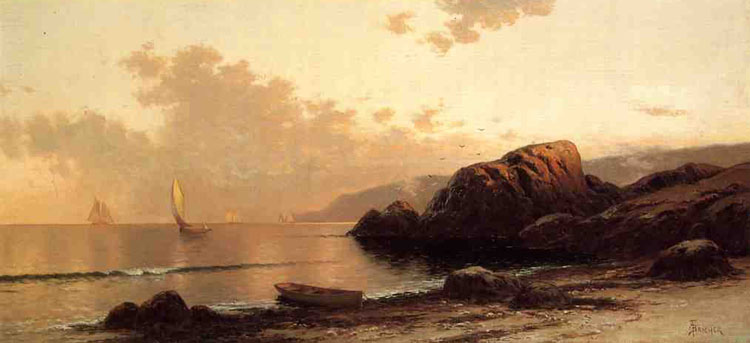
Headlands: Date Unknown
Throughout this time Bricher earned as much praise for his watercolors as for his oil paintings. He exhibited for the first time with the American Water Color Society in 1873, and as a consequence he was immediately elected to membership in the organization. In 1874 he enjoyed the distinction of having a watercolor included in the Exposition Universelle, Paris, among the American section. In 1879 Bricher was elected an Associate member of the National Academy of Design. His work was seen regularly in the annual exhibitions of both the Academy and the AWC. Bricher also exhibited at the Art Institute of Chicago, the Boston Art Club, and the Gallery of James Gill in Springfield, Massachusetts.
Following a second marriage in 1881, Bricher built a summer home and studio at Southampton, Long Island (his wife's childhood region). By 1884 he had eliminated the human figure from many of his landscape paintings, preferring to render unpopulated, rugged views of the coast near Montauk Point (1882-1885) as well as the expansive coast and quaint villages of Long Island's South Shore (1886-1891). Throughout the 1880s up to his death, Bricher painted the Atlantic Coast at various sites in Maine, Grand Manan Island, Long Island, Massachusetts, and Rhode Island. He later made his home at New Dorp, Staten Island, while maintaining a studio in New York City until the end of his life. By that date, 1908, Bricher's career had spanned a period of momentous evolution in American art, indeed from the era of the Hudson River School to the imminent appearance of Synchromism, or color abstraction. It is little wonder, then, that when Bricher died at New Dorp on September 30, 1908, his obituary in Art News (November 21, 1908) commented, "[Bricher] did not receive the notice in the press that the artist's ability and reputation deserved"-a sentiment shared by today's finest scholars of American nineteenth-century painting. Today works by Bricher are to be found in the permanent collections of many of America's most prestigious museums, most notable among them the Metropolitan Museum of Art, New York, the Brooklyn Museum of Art, the Indianapolis Museum of Art, The Wadsworth Atheneum, the Smithsonian American Art Museum, the White House, the Pennsylvania Academy of Fine Arts, the Carnegie Museums of Pittsburgh, the Dallas Museum of Art, and the Denver Art Museum. © Copyright 2008 Hollis Taggart GalleriesQuoted From: Alfred Thompson Bricher - Biography - Hollis Taggart Galleries
Selected works of Alfred Thompson during his Career

Baily's Island, Maine: ca 1907
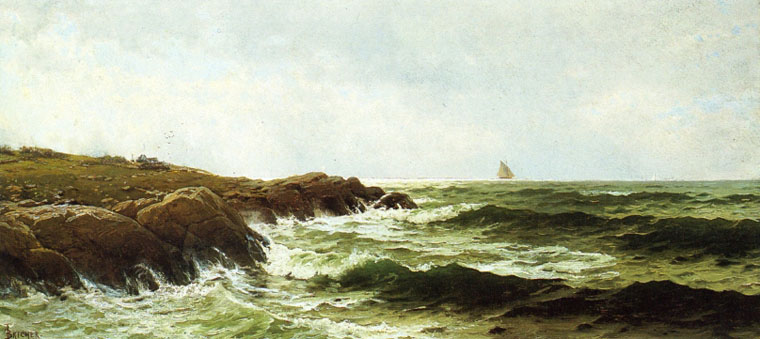
Baker's Island: Date Unknown
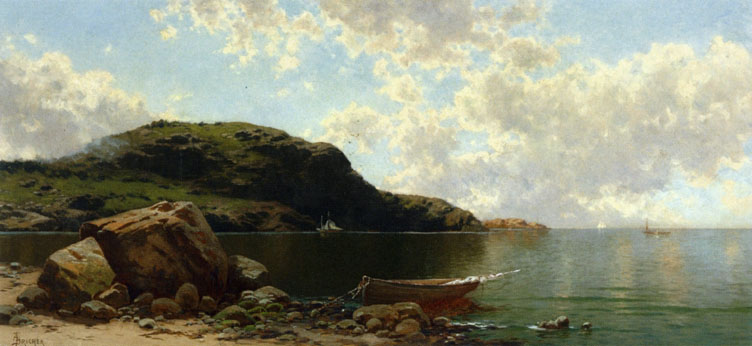
Beach Scene: Date Unknown
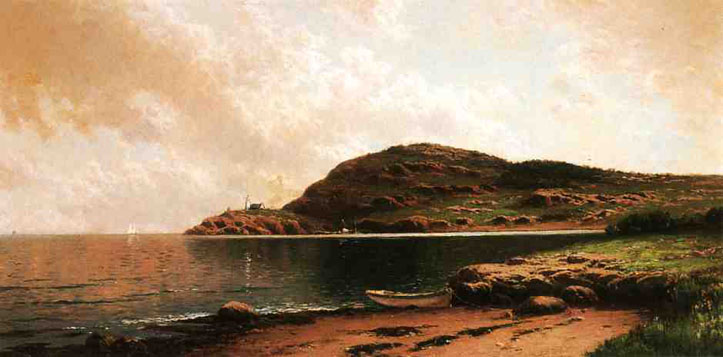
Beached Rowboat: Date Unknown
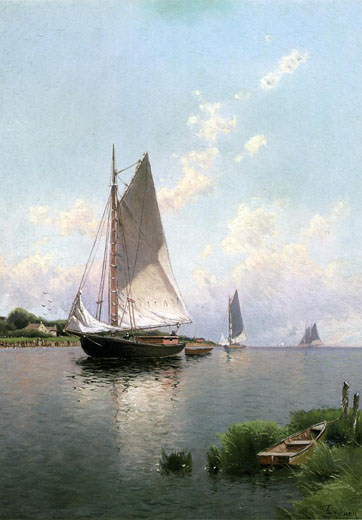
Blue Point, Long Island: 1888
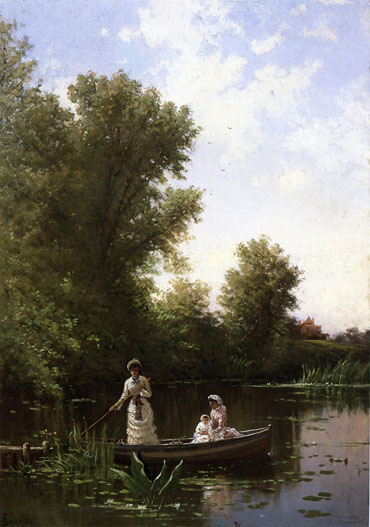
Boating in the Afternoon: ca 1886
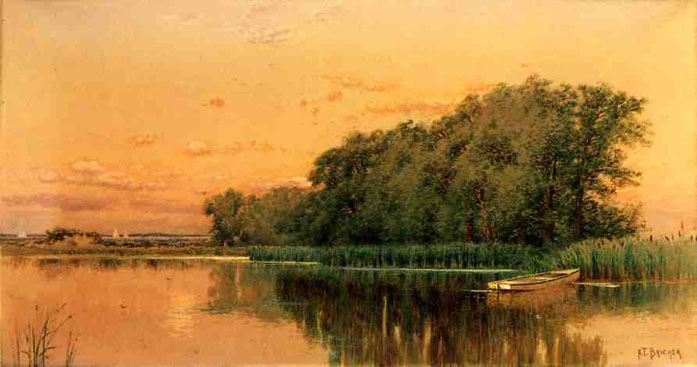
Borders of the North Sea, Southampton, Long Island: Date Unknown
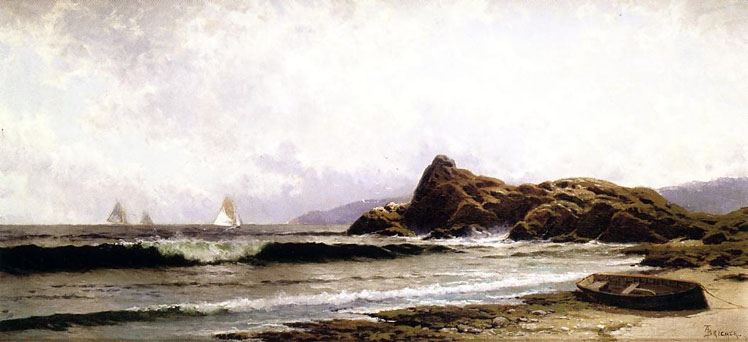
Breaking Surf: Date Unknown

Breaking Surf: Date Unknown
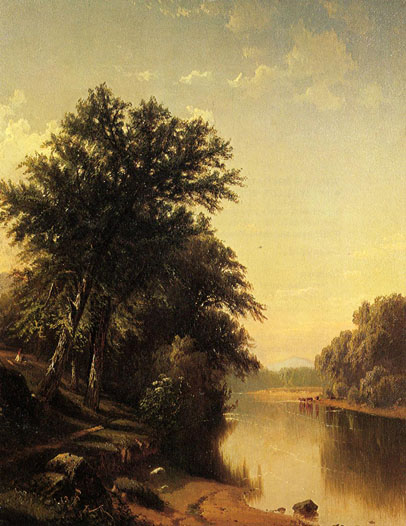
By the River: 1899
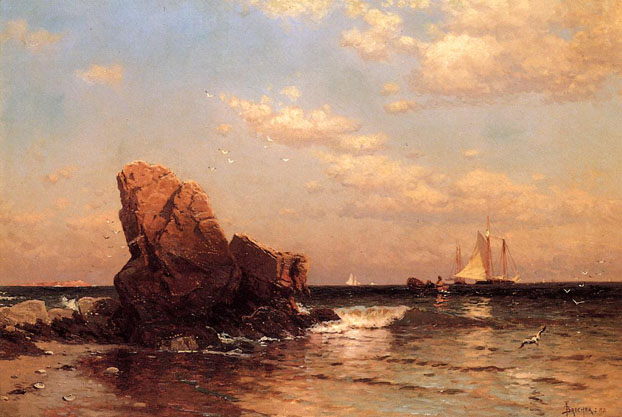
By the Shore: 1883
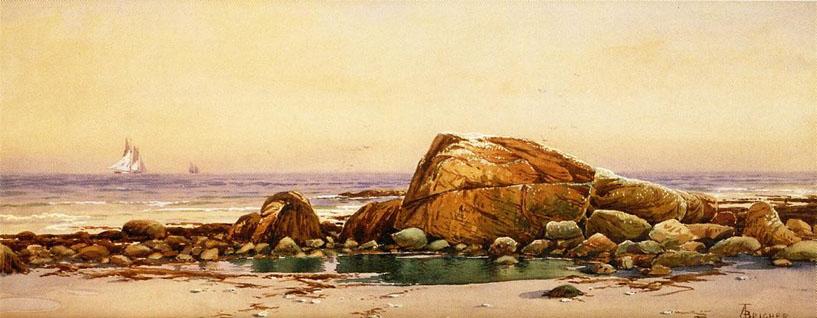
Calm Morning, Mawomet: Date Unknown
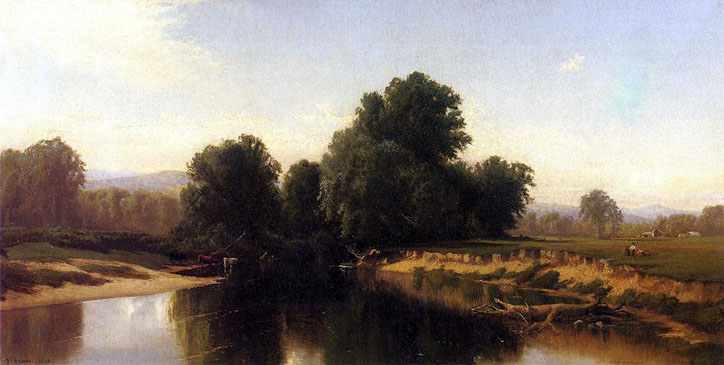
Cattle by the River: 1866
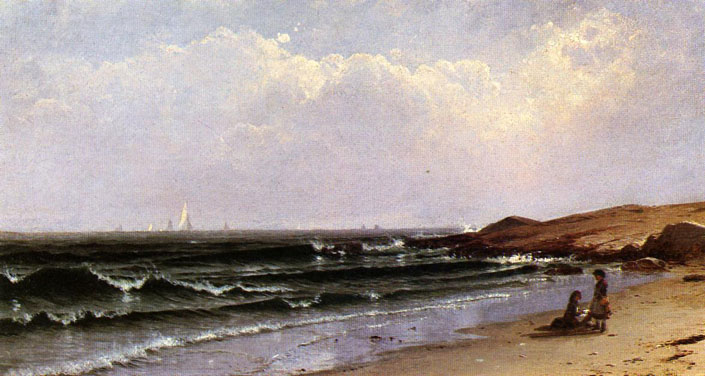
Children at the Seashore: 1874

Cliff Island, Maine: Date Unknown
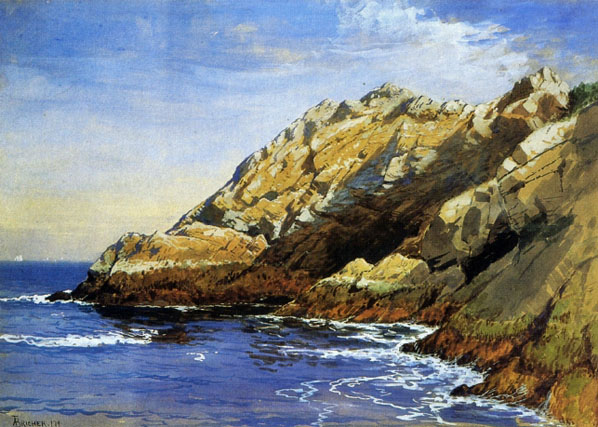
Cliffs, Dana's Island: 1879
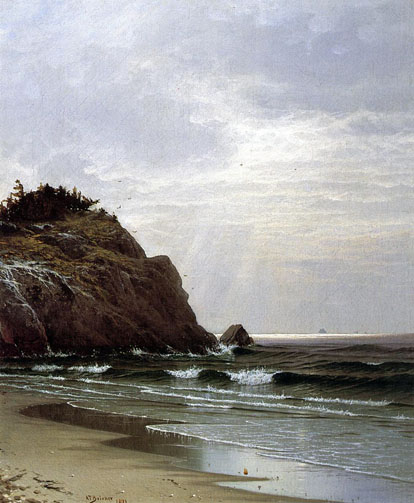
Cloudy Day, Great Head: 1871

Coast Landscape: ca 1878
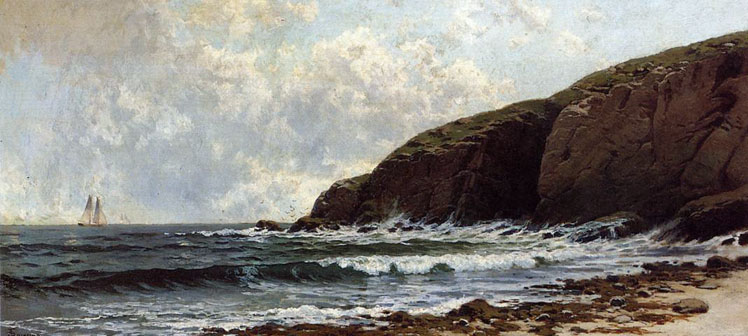
Coastal Scene: Date Unknown
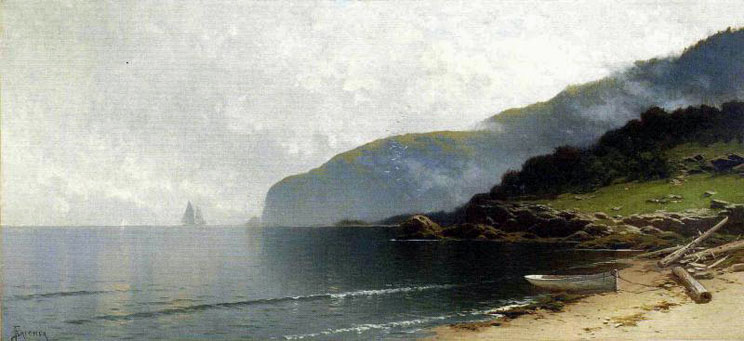
Coastal Scene: Date Unknown

Coastal Scene with Lighthouse: 1875
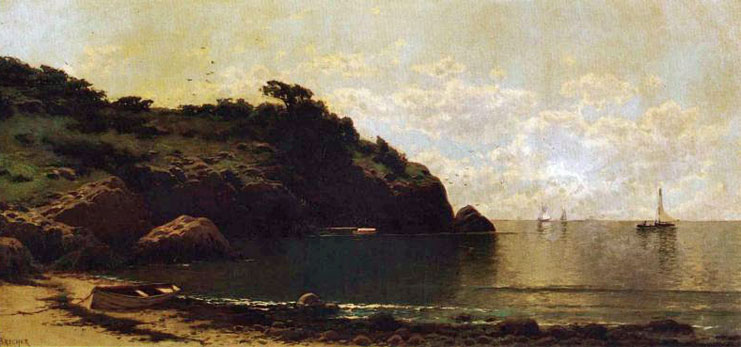
Coastal View: Date Unknown
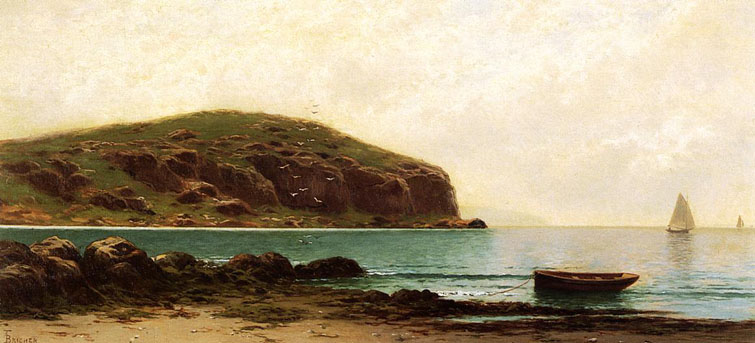
Coastal View: Date Unknown
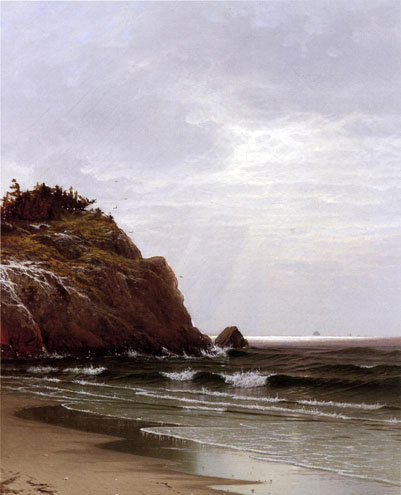
Coastal View, Newport: 1871
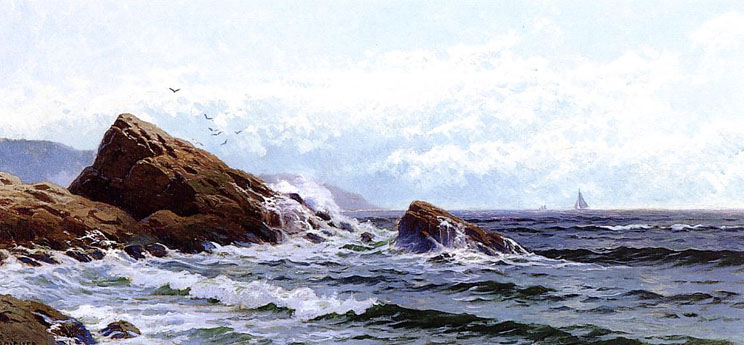
Crashing Waves: Date Unknown
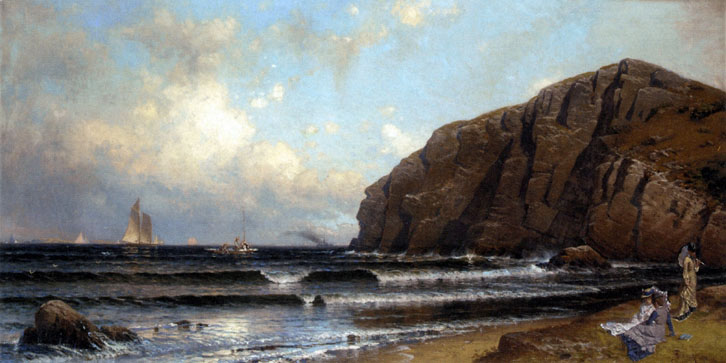
Cushing Island, Portland Harbor: Date Unknown
![]()
Distant Beacon: ca 1880-84

Dory on Dana's Beach, Manchester by the Sea, Massachusetts: 1879

Drifting: 1886

Drying the Main at Anchor: Date Unknown
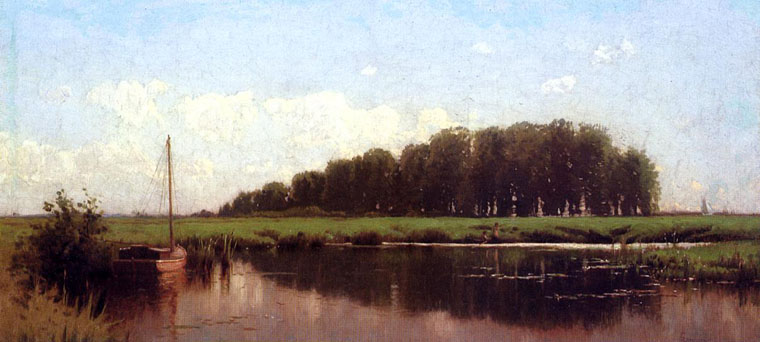
Duck Shootig on the Marshes: ca 1875-80
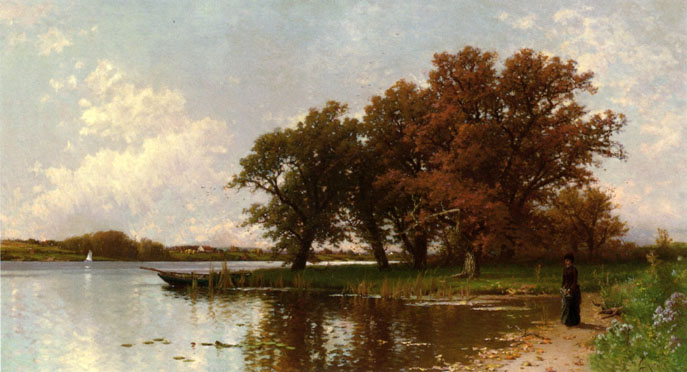
Early Autumn on Long Island: 1868-90
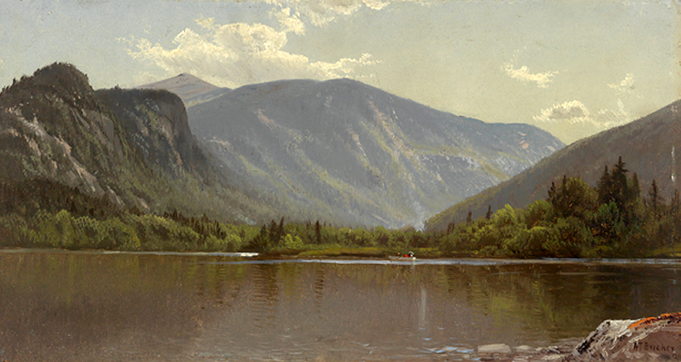
Echo Lake, New Hampshire: ca 1860-70

Evening at Scituate, Low Tide: Date Unknown
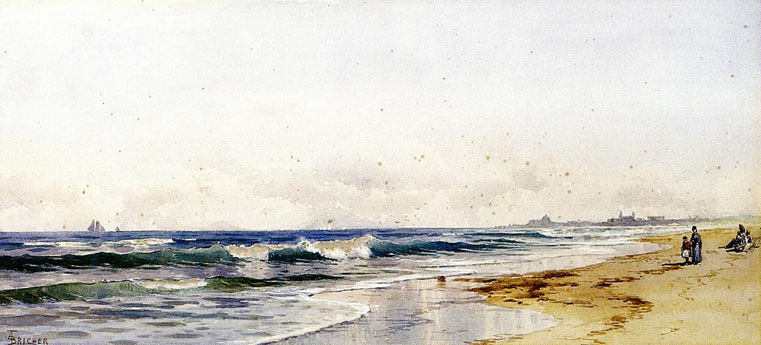
Far Rockaway Beach: Date Unknown
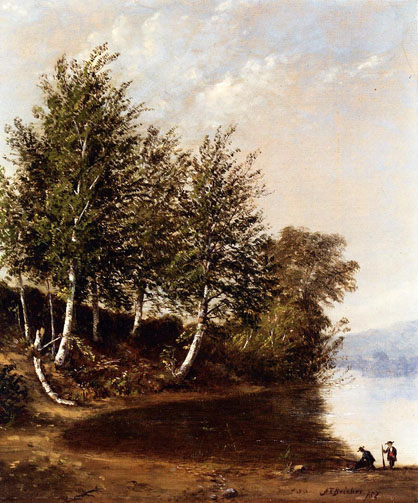
Figures in a Landscape: 1857
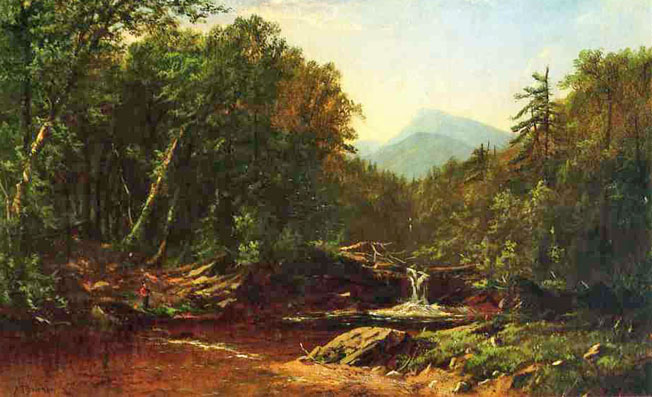
Fisherman by a Mountain Stream: Date Unknown

Harbor Scene and White Sails: 1871
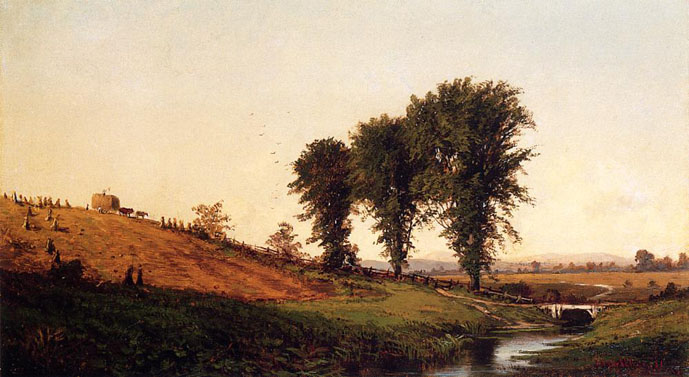
Haying: 1861

Indian Rock, Narragansett Bay: 1871
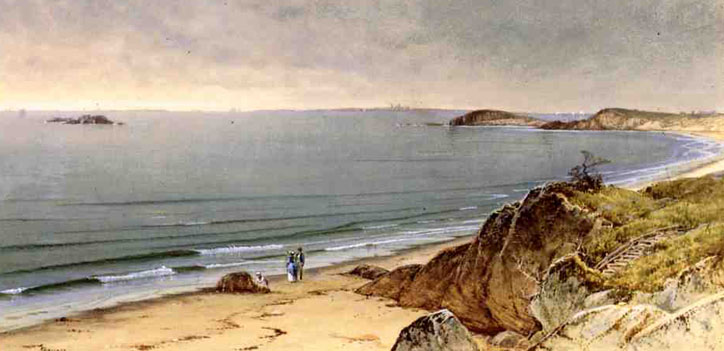
Indian Rock, Narragansett Bay: 1874
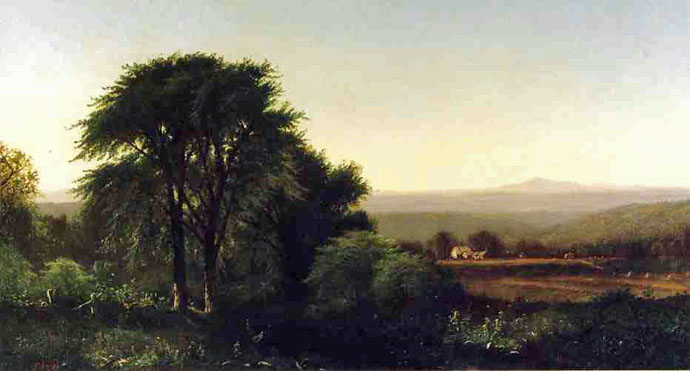
July Afternoon in Greenfield, Massachusetts: 1869
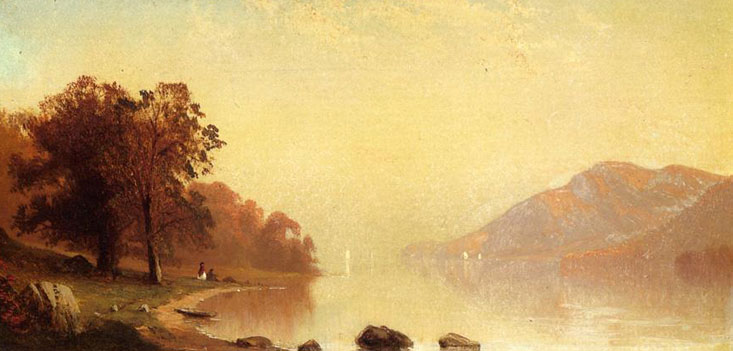
Lake George: 1867
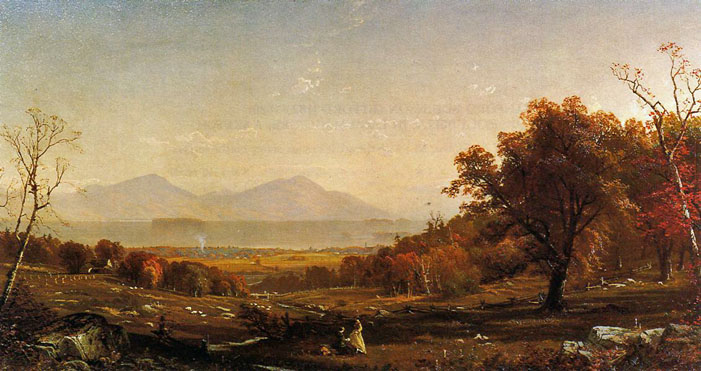
Lake George from Bolton: 1867

Landscape with Children on a Bridge: Date Unknown
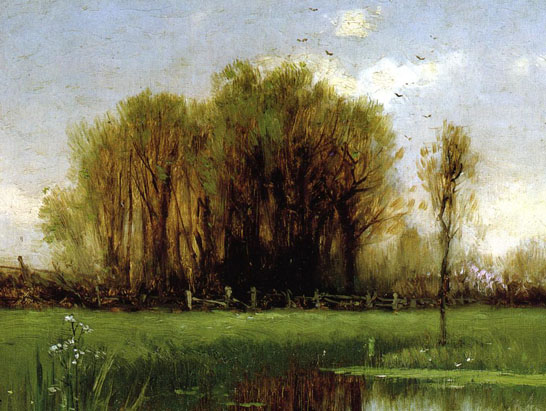
Landscape with Water: Date Unknown
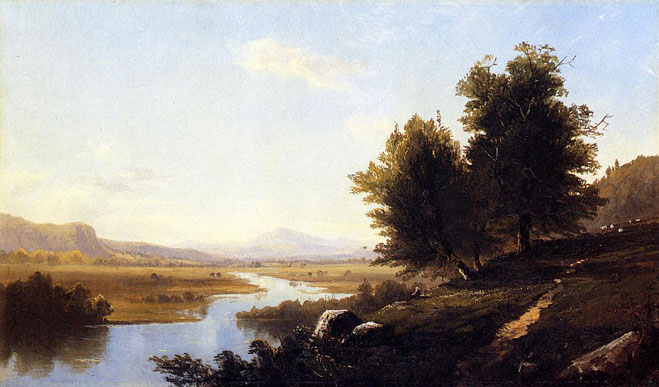
Landscape, The Saco from Conway: 1867
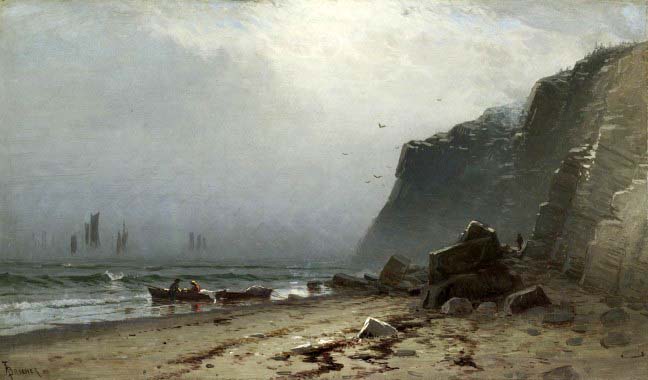
Lifting Fog, Grand Manan: ca 1876
In Lifting Fog, a beam of sunlight breaks through the clouds and announces the first rustlings of day-birds flying above the lake and a couple setting off from shore. These signs of life are in direct contrast to the barren landscape of A Lift in the Fog, which features an overturned rowboat tethered to the shore. Such variations were an essential part of Bricher's studio method, in which he transformed the sketches from his travels into larger paintings. By cataloguing the moments when fog descends or recedes, Lifting Fog and A Lift in the Fog provide variations on the landscape's past, present, and future, locating the life of the island in time.
The movement of the people, birds, and piercing light in Lifting Fog captures a more animated moment in time. The figures take the piece outside the realm of the studio, activating the landscape with their presence. A third figure stands farther back on the shore, cloaked in the shadow of the colossal cliffs. His tiny form conveys the astounding grandeur of the island, which boasted four-hundred-foot cliffs and mammoth tides. Using human figures to provide scale was a common method among Hudson River School artists, but Bricher makes the device his own by turning the figure into a shadowy observer. As the specter gazes into the depths of the sea-where mist consumes the bodies of sailboats hovering over the horizon line-he literally figures its awe-inspiring power.
Quoted From: Lifting Fog, Grand Manan

Light Winds: Date Unknown

Little Bass Rock, Narragansett Pier: Date Unknown
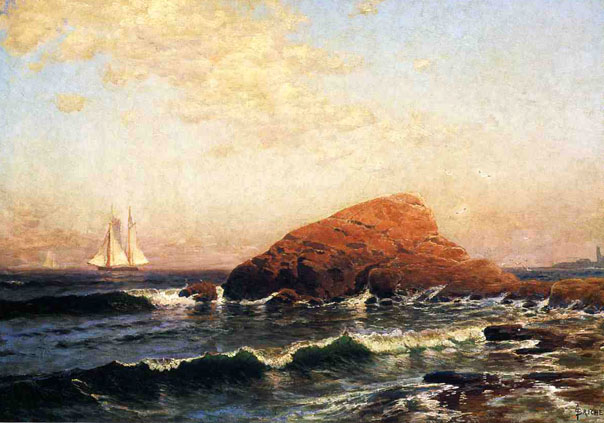
Little Bass Rock, Narragansett, RI: Date Unknown
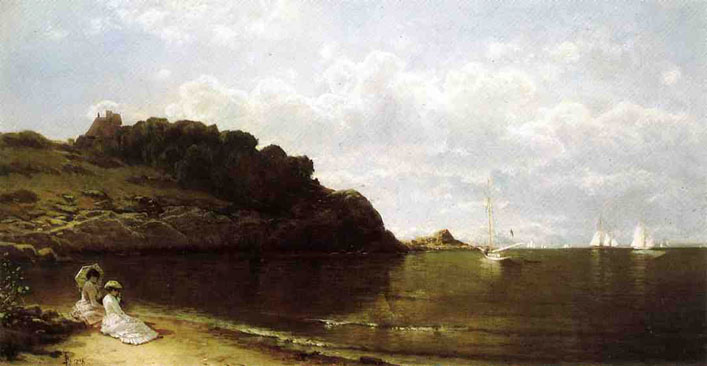
Looking out to Sea: Date Unknown
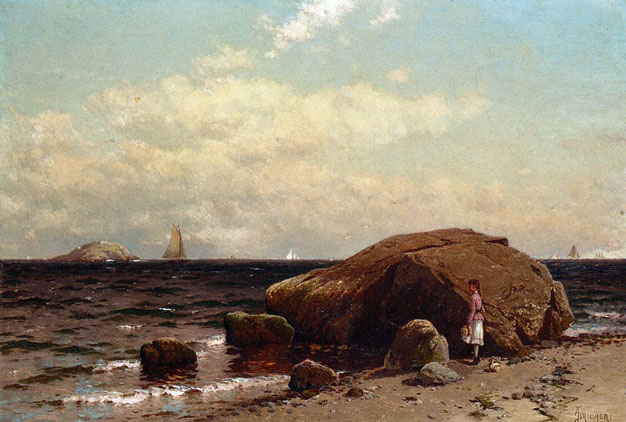
Looking out to Sea: Date Unknown
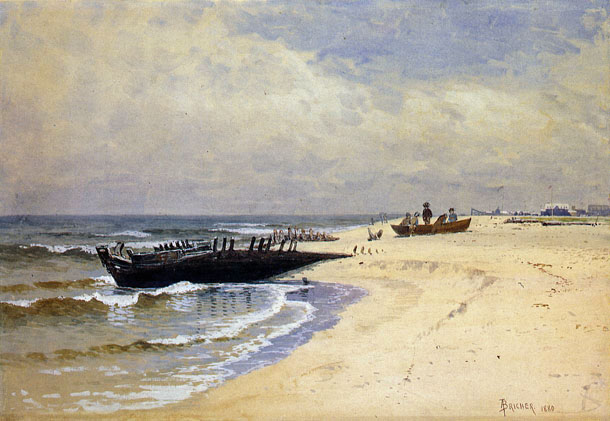
Low Tide: 1880

Low Tide: Date Unknown
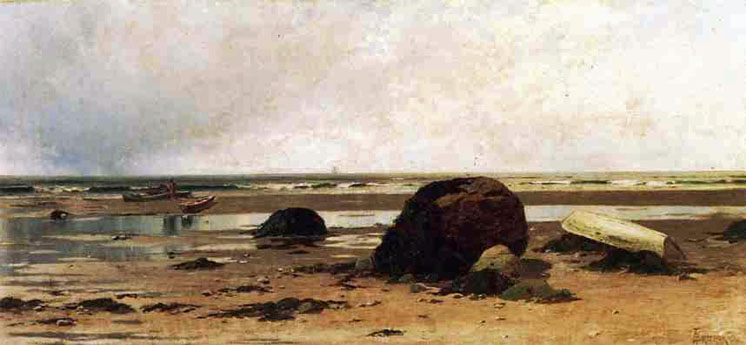
Low Tide: Date Unknown

Low Tide, Narragansett Bay: Date Unknown
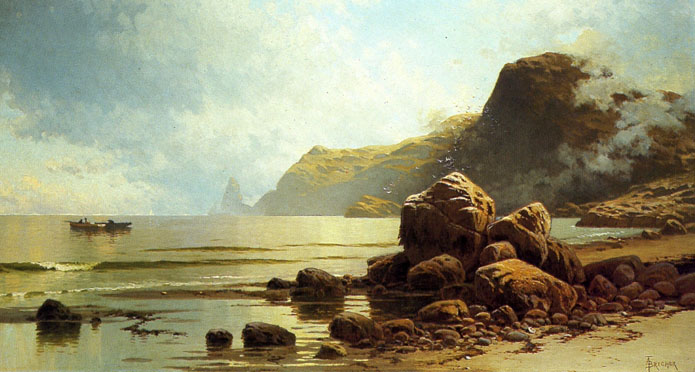
Low Tide, Southhead, Grand Manan Island: Date Unknown
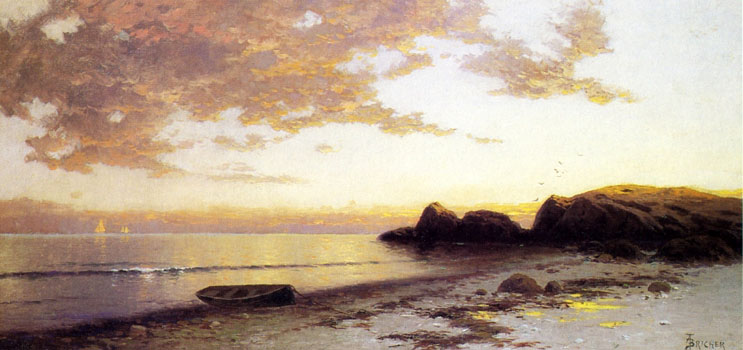
Maine Coast: Date Unknown
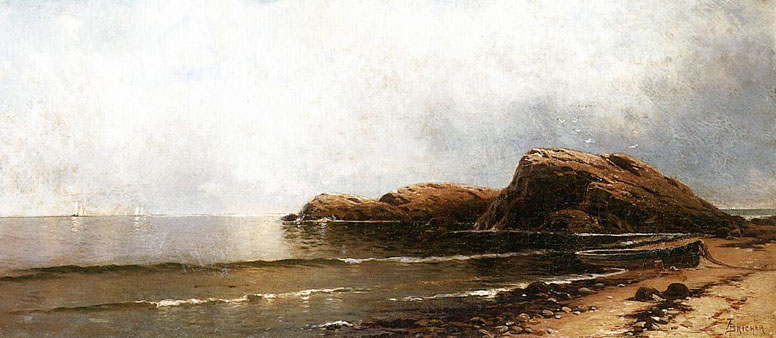
Maine Coast: Date Unknown
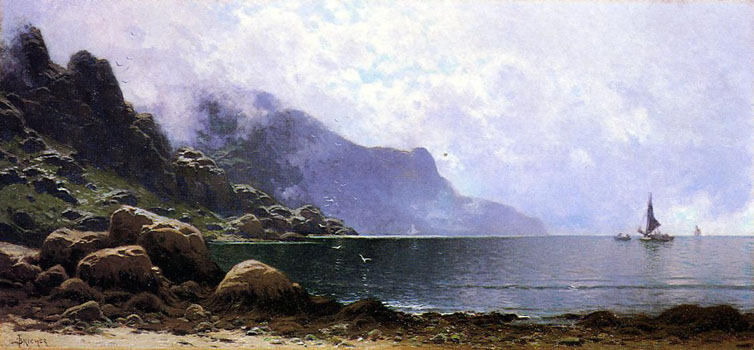
Mist Clearing, Grand Manan: Date Unknown

Mist Rising off the Coast: Date Unknown

Misty Day, Grand Manan: Date Unknown
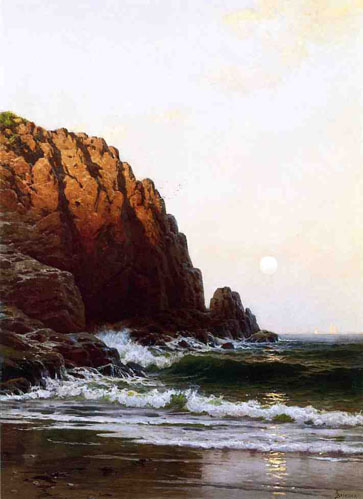
Moonrise, Coast of Maine: Date Unknown

Morning after a Stormy Night: 1895
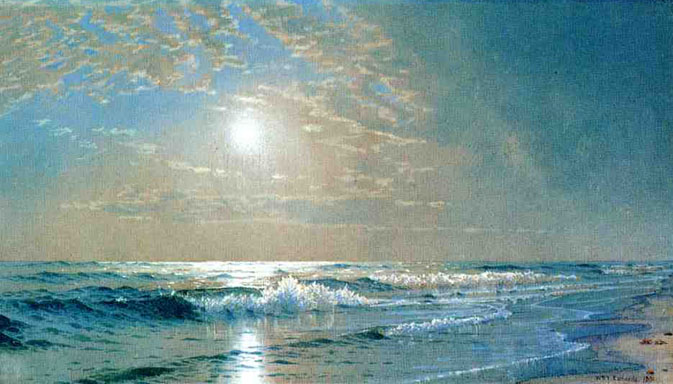
Morning at Atlantic City, New Jersey: 1871
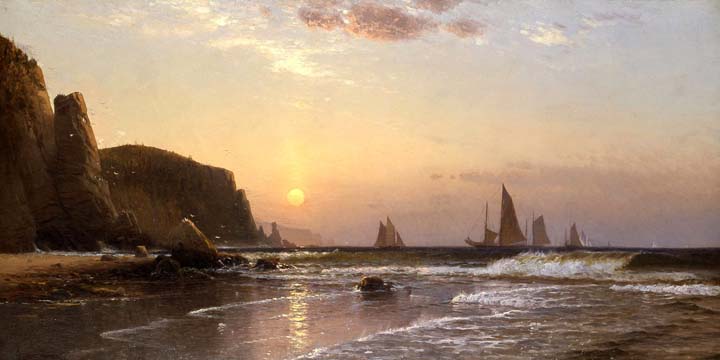
Morning at Grand Manan: 1878
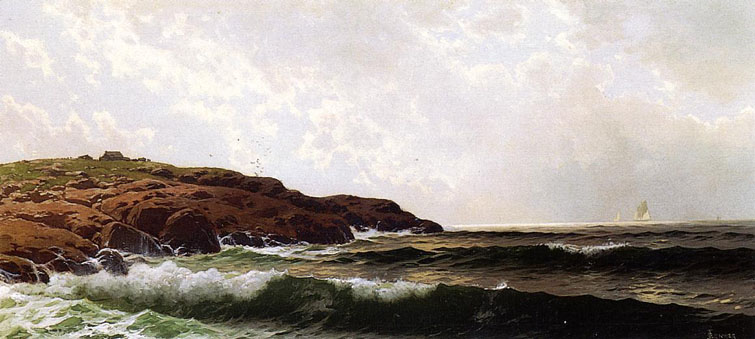
Morning at Sakonnet, Rhode Island: Date Unknown
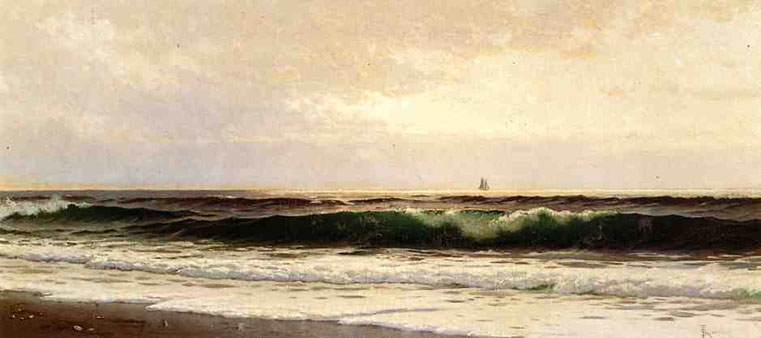
Morning, Salisbury Beach: Date Unknown
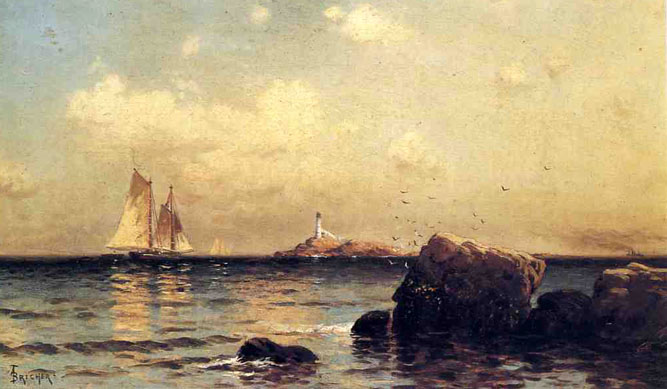
Mule Island, Isle of Shoals: Date Unknown
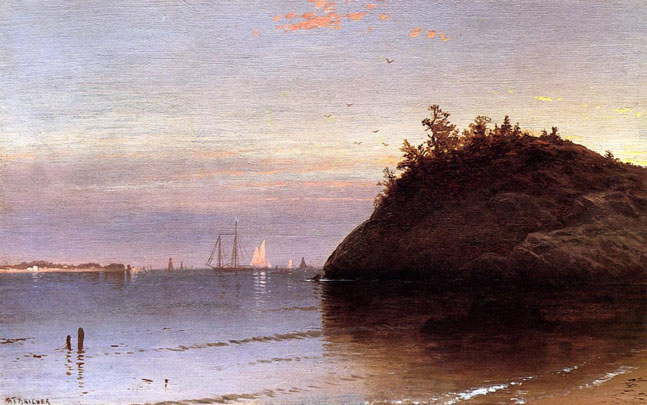
Narragansett Bay: Date Unknown

Narragansett Seascape: 1879
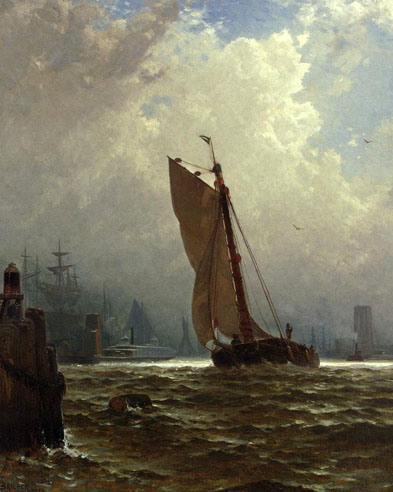
New York Harbor with the Brooklyn Bridge Under Construction: 1877

Newport Beach: 1872
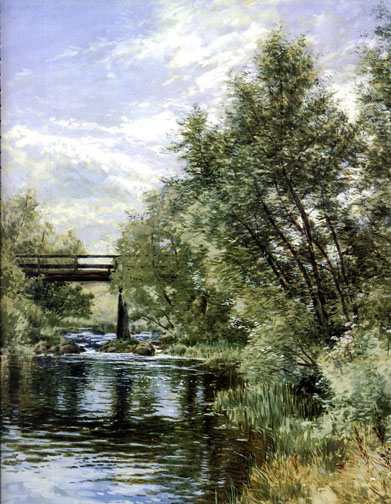
Ogunquit, Maine: Date Unknown
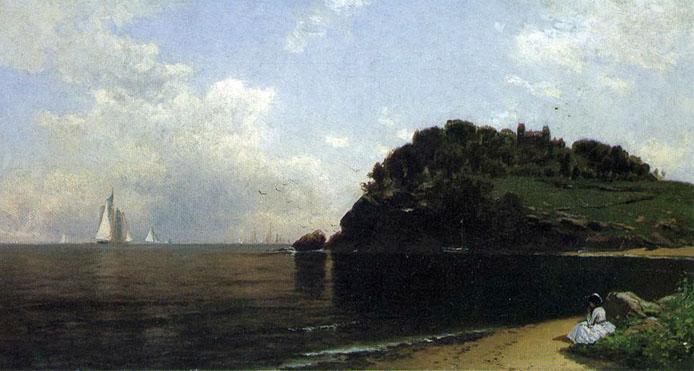
On Long Island Sound: Date Unknown
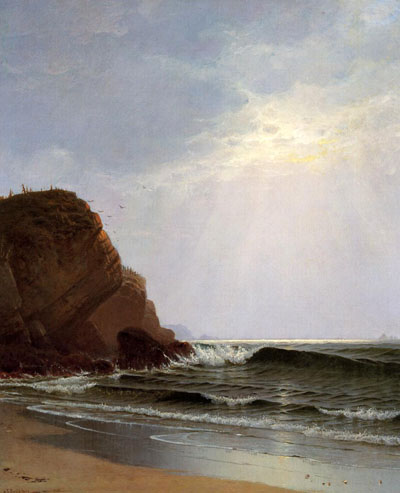
Otter Cliffs, Mount Desert Island, Maine: ca 1871
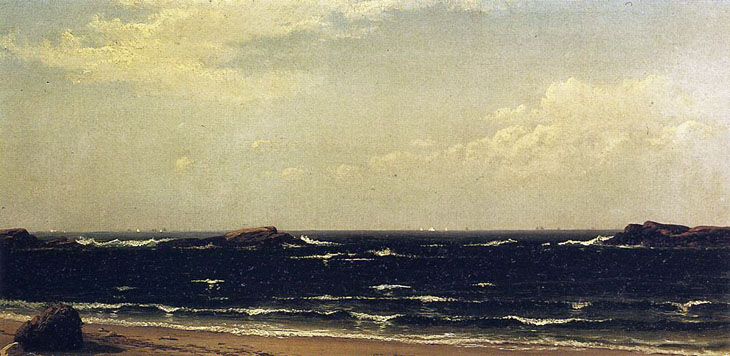
On the Beach, High Noon: Date Unknown
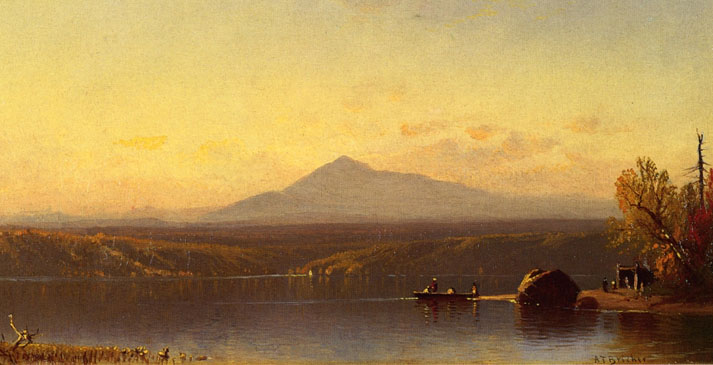
On Walkin Pond, New Hampshire: Date Unknown
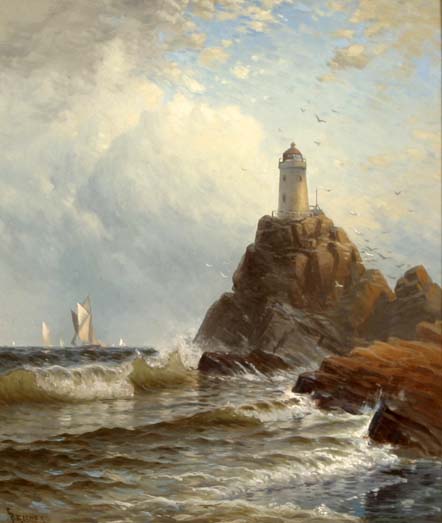
Promontory Lighthouse: ca 1876
The character and romance of the Northeast's picturesque coast was a favored subject of A.T. Bricher. Rich in coastal atmosphere, this painting shows Bricher's interpretation of the familiar lighthouses that guard New England's rocky shores. Not yet identifiable as a specific structure, the solitary lighthouse, perched serenely on its rocky promontory, most likely drew elements from several such towers to create an ideal for his composition.
As rolling surf breaks below and small pleasure craft cruise leisurely offshore, a seagull flock circles the lighthouse, which stands silhouetted against the pleasant cloud filled sky. Bricher's feel for the essence of natural light and the ever changing qualities found along New England's shoreline has produced an expressive portrayal of the region's unique character and natural beauty.
Quoted From: Alfred Thompson Bricher's Maritime Paintings and Art - Promontory Lighthouse
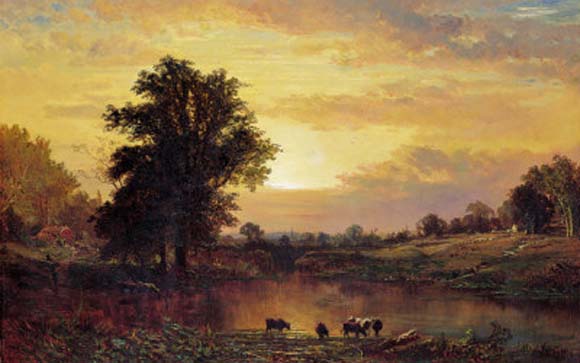
Sunset in the Catskills: 1862
This tranquil rendering of the sun setting in the Catskill Mountains of New York State creates a vision of the American landscape as a peaceful paradise. Much of the American landscape, however, was anything but peaceful when Bricher painted this work. The illusion of harmony created by the portrayal of satisfied cows, a red barn, and trees framing a sunlit middle ground was derived from European landscape conventions, belying the bloody Civil War battles of the 1860's.
Quoted From: BYU - eMuseum

The Landing at Bailey Island, Maine ca 1907
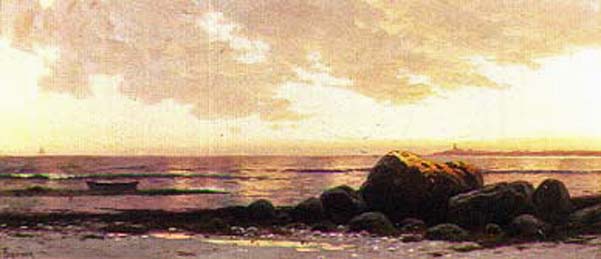
Point Judith, Narragansett, Rhode Island: ca 1885
In this piece, there is no sign of man -- just Nature in all Her glory. The dispersing clouds of sunset are reflected in the pattern of the waves of the sea and all is bathed in a sublime light that reveals the tranquil power of the sea shore. Oddly, Bricher continued painting these peaceful scenes of nature even at the height of the horrors of the Civil War, a war in which he younger brother was killed. His perseverence in this style underscores his belief in the eternal forgiveness of Nature and the truism that whatever the acts of man, Nature is the more powerful force.
Quoted From: Alfred Thompson Bricher Acquisition

The Open Coast: ca 1885
An excellent work showing the precision frequently present in his oils, Bricher brings forth similar ships of different scale. Focusing on sailing subjects, he presents an accomplished overview of a vast distance of this Northeast Coast anchorage. An expanse of clouds fill the sky, offering light variation over the promontory headland, and his brush application suggests wood textures and deep color for the hulls, the largest resting on bottom with the tide.
The unusual presentation, for a Bricher painting, of a foreground composition with well-defined vessels enhances the work's appeal. Note the paced variation of diminutive waves rolling shoreward across the translucent water with accents of sunlight. A lone figure stands along the smaller starboard cabin. One must wonder what's in hand- an anchor line, a fishing pole or perhaps a drift net- at the end of the rope.
Bricher, as this canvas attests, helped define the luminous school that was fundamentally devoted to displays of light and air. He strongly influenced American marine painting and helped produce some of its finest moments. Working primarily in the Boston area and later in New York, he traveled nearly every summer up the Northeast Coast looking for the seasonal qualities of light he desired, and that his art is now much in demand for depicting.
Quoted From: Alfred Thompson Bricher's Maritime Paintings and Art - The Open Coast
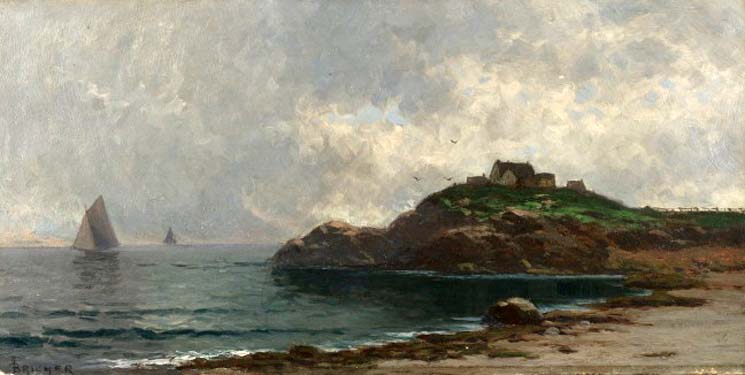
The Overlook
The seascapes of Alfred Thompson Bricher embrace both realism and sublimity. While his works are masterpieces of beauty in great detail, they are also mesmerizing in their commitment to conveying atmospheric serenity. The widespread popularity that Bricher experience during his time, proven by his significant exhibition history, is testament to his ability to capture both literal excellence in nature as well as its figural beauty.
Quoted From: The Overlook
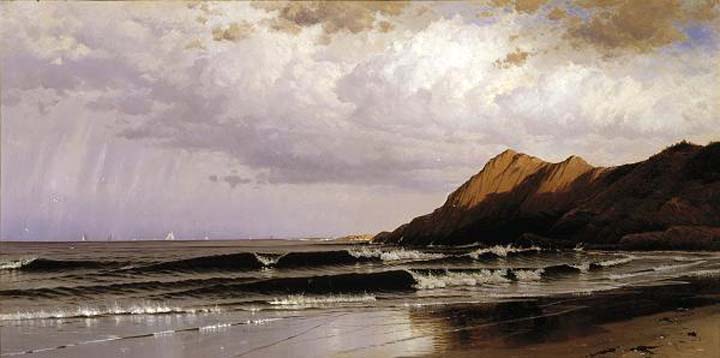
Time and Tide: ca 1873
"Time and tide tarry for no man," wrote Sir Walter Scott in "The Antiquary" (1816), a sentiment echoed by Charles Dickens in his 1844 "Martin Chuzzlewit:" "Time and tide will wait for no man, saith the adage, but all men have to wait for time and tide." Virtually all the viewer sees in this painting is the eternal ebb and flow of the tides against the shore. All human activity has been pushed far away to the background, while nature does its ceaseless work. "Time and Tide" is Alfred Thompson Bricher's masterpiece.
Quoted From: Dallas Museum of Art
Return to Pagina Artis
Return to Bruce and Bobbie's Main Page.